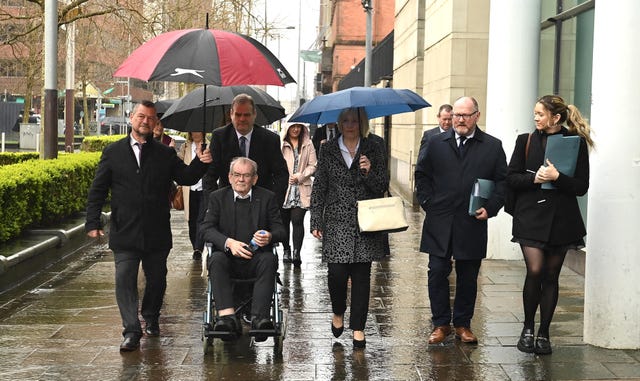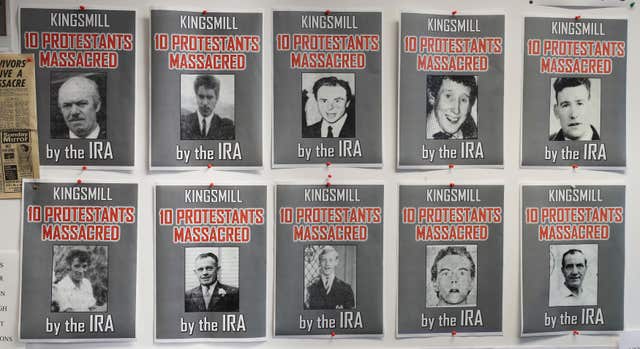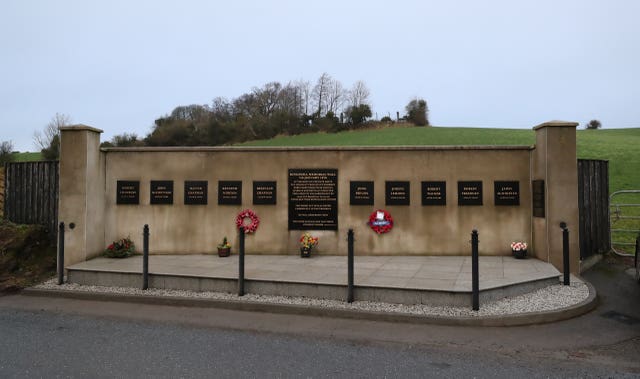Ten murders at Kingsmill an ‘overtly sectarian attack by IRA’, coroner rules
A little-known republican paramilitary group had claimed responsibility for the 1976 shootings.

The shooting dead of 10 Protestant workmen at Kingsmill in Co Armagh in 1976 was an “overtly sectarian attack by the IRA”, a coroner has ruled.
The atrocity at Kingsmill, which was one of the most notorious of the Troubles, was claimed by a little-known paramilitary group calling itself the South Armagh Republican Action Force.
It was long seen as a front for the IRA, which was supposedly on ceasefire at the time of the sectarian massacre.
In remarks that took over four hours to read to Belfast Coroner’s Court, Mr Sherrard also dismissed as “utter fantasy” rumours that British Army Captain Robert Nairac infiltrated the IRA and was involved in the Kingsmill massacre.
In a further finding, the coroner said there seemed to have been a “reluctance on the part of the Irish State” to acknowledge the role of the border in the Kingsmill atrocity, noting that it was at least in part organised in the Republic of Ireland.
Following the conclusion of the inquest, the sole survivor of the shooting Alan Black and relatives of one of the victims called for a public inquiry into the attack, insisting the coronial proceedings had failed to answer their questions.

“We’re not anywhere near the truth,” Mr Black said outside court.
“We need a public inquiry. I would call on everyone that has a friend that got hurt to back us in getting this public inquiry because we’re never going to get the truth without it.”
The 10 workmen were murdered on January 5 1976 when their minibus was ambushed by a gang of at least 12 men posing as British soldiers outside the village of Kingsmill on their way home from working at a textiles factory.

The killers forced the 11 remaining men to line up outside the van before opening fire.
Mr Black survived despite being shot multiple times.
No-one has ever been convicted of the Kingsmill murders.
The 10 men who died were Robert Chambers, 18; John Bryans, 46; Reginald Chapman, 29; Walter Chapman, 35; Robert Freeburn, 50; Joseph Lemmon, 46; John McConville, 20; James McWhirter, 58; Robert Walker, 46; and Kenneth Worton, 24.

The coroner said the “glaring omission” in the proceedings had been the absence of any evidence from those who caused the attack.
“The glaring omission in the inquest was the absence of any disclosure or evidence from those who caused the deaths,” he said.
“Unlike other legacy inquests which have examined the actions of the state in directly causing death, those responsible for the deaths at Kingsmill have not given an account either personally or through any organisation or any political party.
“Numerous calls to assist and provide answers were met with silence.
“Accordingly, the inquest did not receive disclosure from any individual concerned in the attack, nor their organisation, nor their political representatives, although expert evidence was given that records may well exist.”
He said: “Neither did the inquest hear evidence from the perpetrators regarding matters such as the motivation for the attack, its planning and personnel and its execution.
“There has been no recognition by any perpetrator or their organisation or political representatives as to the utter wrongness of the attack which served to end the lives of 10 men and to devastate the lives of untold others.”
As Mr Black and bereaved relatives watched from the public gallery of the court in Belfast, Mr Sherrard outlined extensive ballistics evidence linking the weapons used at Kingsmill to a series of attacks carried out by the IRA.
He said the “unassailable” evidence showed that the guns fired at Kingsmill were the “exclusive property” of the IRA.
Mr Sherrard rejected the claim that the “rogue” republican group had carried out the attack as a “lie”, insisting it was perpetrated by the IRA, which used a “cynical ploy” to mask its involvement in “nakedly sectarian killings”.

Mr Sherrard acknowledged the “ostensible” link to the attacks on the O’Dowd and Reavey families, but he made clear that planning for the Kingsmill shootings had started “long before” the targeting of those two families.
Mr Sherrard said rumours around Captain Nairac’s involvement in Kingsmill had persisted for many years, but he said he was entirely satisfied that he had “no role whatsoever” in the atrocity.
The British Army officer was abducted by the IRA while on an undercover operation in a pub in south Armagh in 1977, the year after Kingsmill.
He was then taken to Flurry Bridge in County Louth where he was beaten and shot dead. His remains have never been found.
Coroner Sherrard also dismissed any suggestion that the perpetrators of Kingsmill were not pursued by the authorities in order to protect an IRA informant, describing it as “unhelpful conspiracy theorising”.
“Such an assertion is entirely without foundation,” he said.
Two individuals identified as suspects in the Kingsmill attack were later given contentious so-called comfort letters issued by the UK Government to On The Run (OTR) republican suspects during the peace process.
He also outlined various errors and omissions in the police investigation in the wake of the shooting.
But he insisted those should be viewed in the context of the time and said there should be no attempt to shift the blame away from those responsible for the “brutal” murders.
“The investigation was not perfect,” Mr Sherrard said.
“But its deficits can be put down to the abnormal security environment of south Armagh in 1976, the extraordinary demands on the police and the murderous competence of those who executed the atrocity and left without a trace.”
He said there could be “little doubt” that the likely suspects were known to the security forces at the time.
“But common knowledge as to those with means and motive to carry out this heinous act does not amount to evidence,” Mr Sherrard said.





